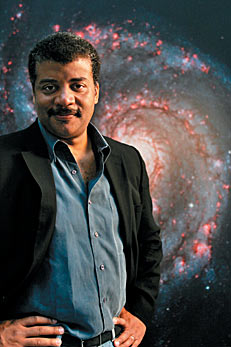Science is sexy (per Ira Flatow)
December 6th, 2012 at 7:38 pm (Society)
 While at the American Geophysical Union meeting this week, I got to attend a lecture by Ira Flatow (host of NPR’s Science Friday). In his talk, “Science is sexy,” he argued that the image of science has changed from that of the scruffy-haired, wrinkled professor to a younger, fresher, more attractive one. As evidence, he cited the “Mohawk guy,” Mythbusters, and several movies and Broadway shows that have employed a scientific theme or concept. Popularizing science is one thing, but sexualizing it is another. He offered a smorgasbord of other examples that ranged from amusing (the Big Bang Theory, or “what would happen if Friends were physicists”) to offensive (“It’s a Girl Thing” video) to delightfully clever (“The Longest Time” video on divergent evolution).
While at the American Geophysical Union meeting this week, I got to attend a lecture by Ira Flatow (host of NPR’s Science Friday). In his talk, “Science is sexy,” he argued that the image of science has changed from that of the scruffy-haired, wrinkled professor to a younger, fresher, more attractive one. As evidence, he cited the “Mohawk guy,” Mythbusters, and several movies and Broadway shows that have employed a scientific theme or concept. Popularizing science is one thing, but sexualizing it is another. He offered a smorgasbord of other examples that ranged from amusing (the Big Bang Theory, or “what would happen if Friends were physicists”) to offensive (“It’s a Girl Thing” video) to delightfully clever (“The Longest Time” video on divergent evolution).
Ira also cited a paper called “The 95% Solution” which he reported as saying that Americans get only 5% of their knowledge about science from formal education (school). The rest of it, he said, comes from libraries, field trips, aquariums, the Internet, TV, and of course radio shows like Science Friday, which oddly he did not cite. :) But this rather surprising 5% claim turns out not to be quite what the original paper says. The authors note that the average person spends only 5% *of their lifespan* in a classroom. (I am not the average person.) The article encourages directing more resources to these other, non-classroom settings since they in theory have the chance to educate the population in “the other 95%.”
I liked their depiction of the U.S. as having a “vibrant free-choice science learning landscape” — i.e., we enjoy a wealth of opportunities for learning about science. But the article’s deeper argument is a little more radical. If only 5% of one’s lifetime is spent in school, it argues, then the current “school-first” approach of trying to get more and better qualified science teachers in classrooms is not only misdirected, but it doesn’t work. The article notes that although U.S. schoolchildren lag behind their international peers in science literacy, U.S. adults outperform their counterparts (but the article cited no data source, and a web search I conducted suggested that this comes from a study showing that a whopping 28% of U.S. adults have basic science literacy, not exactly a stellar performance, and only barely edging out other countries). Since “only 30% of U.S. adults have ever taken even one college-level science course,” the authors conclude that U.S. adults have been learning science from all of these other sources, not from school.
It’s great that people can learn new things from the world around them, and from informative displays and exhibits that have been set up. But it’s not really surprising; humans are natural scientists and experimenters, as anyone knows who’s watched a toddler for more than two minutes. Is it really the case that teaching science in schools is doomed to failure? Could we not continue working on curriculum innovations instead of giving up and heading to the Science Center IMAX? If the latter, why drag students through school in the first place?
 Ira’s other big message was the need for effective science communication. He illustrated this point with one of my favorite examples, a video of Grace Hopper explaining what a nanosecond is to David Letterman (apparently CBS has yanked all copies of this video clip — very sad!).
Ira’s other big message was the need for effective science communication. He illustrated this point with one of my favorite examples, a video of Grace Hopper explaining what a nanosecond is to David Letterman (apparently CBS has yanked all copies of this video clip — very sad!).
He also noted that Neil deGrasse Tyson will host a new Cosmos show starting next year (woo hoo!).
Okay. Science is sexy.
Evan said,
December 7, 2012 at 1:01 am
How can it be otherwise? This is nearly tautological. :)